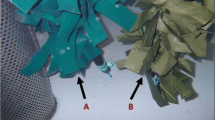Abstract
This study assessed the use of different types of substrates for lumpfish in sea pens. Observations were recorded in the early morning before first light, and the number of lumpfish attached to each surface type was recorded. The substrate was removed and another design was deployed if no lumpfish were attached to a substrate for more than 2 weeks. Lumpfish preferred flat and smooth vertical surfaces of plastic, as very few preferred to attach to stones and car tyres offered. Some lumpfish were also observed attaching to the floating seaweed placed into the cages, a more natural substrate used in the wild. It is concluded that lumpfish will easily adhere to artificial, smooth, plastic surfaces instead of natural surfaces such as kelp. Irrespective of the type of substrate offered, it is critical to the welfare of the fish that they have access to some form of substrate due to the need to rest and attach overnight.

Similar content being viewed by others
References
Boxaspen K (2006) A review of the biology and genetics of sea lice. ICES J Sea Res 63:1304–1316
Brown JA (1986) The development of feeding behaviour in lumpfish, Cyclopterus lumpus. J Fish Biol 29:171–178
Costello MJ (2009) The global economic cost of sea lice to the salmonid farming industry. J Fish Dis 32:115–118
Davenport J (1985) Synopsis of biological data on the lumpsucker Cyclopterus lumpus (Linnaeus, 1958). FAO Fisheries Synopsis no. 147, 31 pp
Denholm I, Devine GJ, Horsberg TE, Sevatdal S, Fallang A, Nolan DV, Powell R (2002) Analysis and management of resistance to chemotherapeutants in salmon lice Lepeophtheirus salmonis (Krøyer) (Copepoda: Caligidae). Pest Man Sci 58:528–536
Hale EM (2000) Startle responses of fish without Mauthner neurons: escape behavior of the lumpfish (Cyclopterus lumpus). Biol Bull 199:180–182
Imsland AK, Reynolds P, Eliassen G, Hangstad TA, Foss A, Vikingstad E, Elvegård TA (2014a) The use of lumpfish (Cyclopterus lumpus L.) to control sea lice (Lepeophtheirus salmonis Krøyer) infestations in intensively farmed Atlantic salmon (Salmo salar L.). Aquaculture 424–425:18–23
Imsland AK, Reynolds P, Eliassen G, Hangstad TA, Foss A, Vikingstad E, Elvegård TA (2014b) Notes on behaviour of lumpfish with and without Atlantic salmon present. J Eth 32:117–122
Ingólfsson A (2000) Colonization of floating seaweed by pelagic and subtidal benthic animals in southwestern Iceland. Hydrobiologia 440:181–189
Ingólfsson A, Kristjánsson BK (2002) Diet of juvenile lumpsucker (Cyclopterus lumpus) in floating seaweed: effect of ontogeny and prey availability. Copeia 2:472–476
Johansen LH, Jensen I, Mikkelsen H, Bjorn PA, Jansen PA, Bergh Ø (2011) Disease interaction and pathogens exchange between wild and farmed fish populations with special reference to Norway. Aquaculture 315:229–243
Lees F, Baillie M, Gettinby G, Revie C (2009) Efficacy of emamectin benzoate sea lice treatments. Fish Farmer 32(2):44–47
Moring JR (1989) Food habits and algal associations of juvenile lumpfish, Cyclopterus lumpus L., in intertidal waters. Fish Bull 87:233–237
Timeyko VN (1986) The digestive system of White Sea cod, Gadus morhua marisalbi, and lumpfish Cyclopterus lumpus, at different stages of ontogeny. J Ichthyol 26:72–82
Torrissen O, Jones S, Asche F, Guttormsen A, Skilbrei OT, Nilsen F, Horsberg TE, Jackson D (2013) Salmon lice—impact on wild salmonids and salmon aquaculture. J Fish Dis 36:171–194
Treasurer JW (2002) A review of potential pathogens of sea lice and the application of cleaner fish in biological control. Pest Managem Sci 58:546–558
Vandendriessche S, Messiaen M, O’Flynn S, Vincx M, Degraer S (2007) Hiding and feeding in floating seaweed: floating seaweed clumps as possible refuges or feeding grounds for fishes. Estuar Coast Shelf Sci 71:691–703
Zar JH (1984) Biostatistical analysis. Prentice-Hall, New Jersey, p 718
Acknowledgments
The authors would like to thank the technical staff at the GIFAS aquaculture research station at Inndyr for valuable assistance prior to and during the experimental period. Financial support was given by the Norwegian Research Council (208614/E40) and the Mabit programme (AF0055).
Author information
Authors and Affiliations
Corresponding author
Additional information
Albert K. Imsland and Patrick Reynolds have contributed equally to this work.
Rights and permissions
About this article
Cite this article
Imsland, A.K., Reynolds, P., Eliassen, G. et al. Assessment of suitable substrates for lumpfish in sea pens. Aquacult Int 23, 639–645 (2015). https://doi.org/10.1007/s10499-014-9840-0
Received:
Accepted:
Published:
Issue Date:
DOI: https://doi.org/10.1007/s10499-014-9840-0




